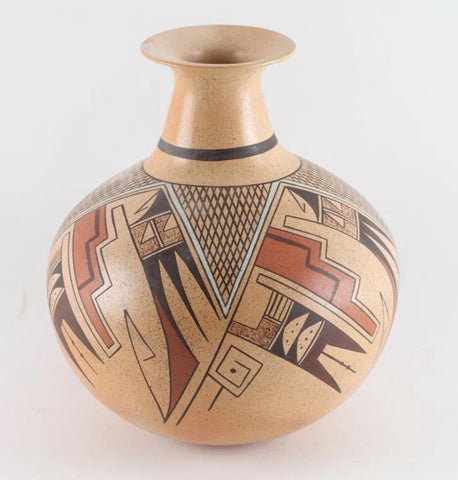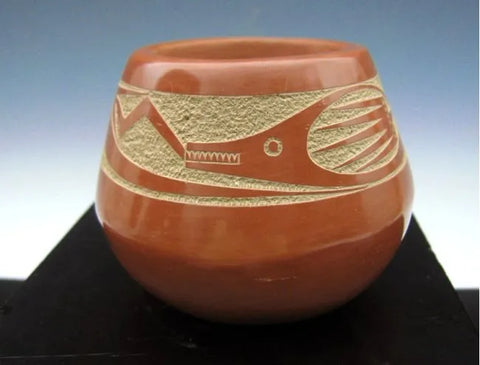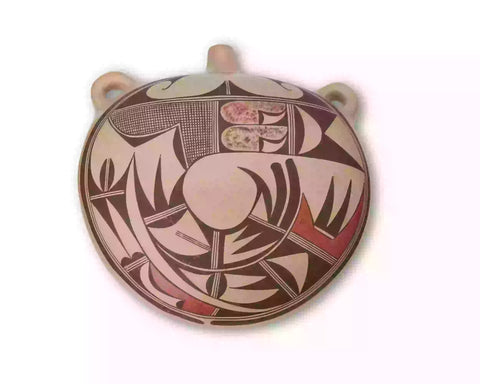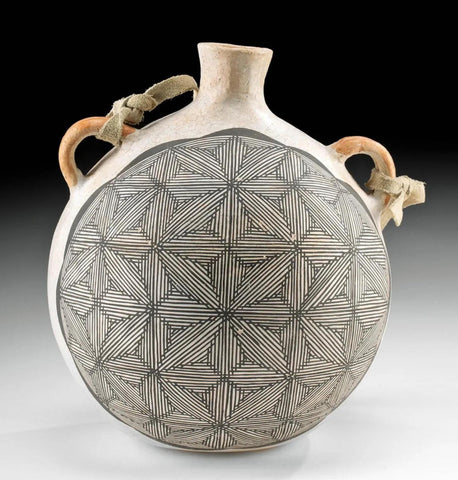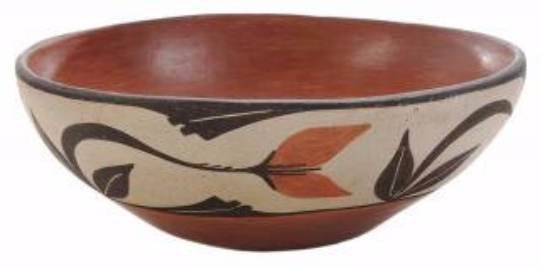
Native American Vintage Santo Domingo Pueblo Pottery Bowl Ca 1960's, #1067 Sold
$ 1,225.00
Native American
Vintage Santo Domingo Pueblo Pottery Bowl Ca 1960's, #1067
#1067: Description: Native American Vintage Santo Domingo Pueblo Pottery Bowl Ca 1960's,
Dimensions: 4.75" x 11 .75"
Condition: Excellent condition.
Provenance: From the Estate of Marcus King, Blountville, Tennessee.
Background on Marcus King: Marcus King Blountville, Tenn. Marcus King, age 79, passed away peacefully on Thursday morning, August 18, 2016. By his side was his loving lady friend, Donna Fleenor. Marcus was a researcher, collector, and dealer of antiques. He was field researcher for the Cultural Heritage Project for over 3 years at the William King Museum of Arts. He was involved as consultant for numerous exhibits, articles, and books. Considered by some, the expert of Southwest Virginia and East Tennessee Decorative Arts. He was predeceased by his wife of 49 years, Elinor Rollins King; his brother, David King; and his parents, Carroll and Mary Kate King. He is survived by his children, Gregory King of Jonesbourgh, Tenn., Gretchen Neal (Bill) of Blountville, Tenn., Mary Katherine Winters (Richard) of Knoxville, Tenn., and Sharon Clingan (Mark) of Stafford, Va.; his grandchildren, Matthew and Amanda Neal, Courtney and Nicolas Winters, and Morgan, Erin, and Ian Clingan; his brother, Paige King (Jeanie) of Salem, Va.; and lifelong friend, Roddy Moore of Ferrum, Va. A memorial service will be held at Green Springs Presbyterian Church, 22007 Green Springs Church Rd., Abingdon, VA 24211 on Friday, August 26, 2016, at 4 p.m.
Making of Pueblo Pottery: “Pueblo pottery is made using a coiled technique that came into northern Arizona and New Mexico from the south, some 1500 years ago. In the four-corners region of the US, nineteen pueblos and villages have historically produced pottery. Although each of these pueblos use similar traditional methods of coiling, shaping, finishing and firing, the pottery from each is distinctive. Various clays gathered from each pueblo’s local sources produce pottery colors that range from buff to earthy yellows, oranges, and reds, as well as black. Fired pots are sometimes left plain and other times decorated—most frequently with paint and occasionally with appliqué. Painted designs vary from pueblo to pueblo, yet share an ancient iconography based on abstract representations of clouds, rain, feathers, birds, plants, animals and other natural world features.
Tempering materials and paints, also from natural sources, contribute further to the distinctiveness of each pueblo’s pottery. Some paints are derived from plants, others from minerals. Before firing, potters in some pueblos apply a light colored slip to their pottery, which creates a bright background for painted designs or simply a lighter color plain ware vessel. Designs are painted on before firing, traditionally with a brush fashioned from yucca fiber.
Different combinations of paint color, clay color, and slips are characteristic of different pueblos. Among them are black on cream, black on buff, black on red, dark brown and dark red on white (as found in Zuni pottery), matte red on red, and polychrome—a number of natural colors on one vessel (most typically associated with Hopi). Pueblo potters also produce undecorated polished black ware, black on black ware, and carved red and carved black wares.
Making pueblo pottery is a time-consuming effort that includes gathering and preparing the clay, building and shaping the coiled pot, gathering plants to make the colored dyes, constructing yucca brushes, and, often, making a clay slip. While some Pueblo artists fire in kilns, most still fire in the traditional way in an outside fire pit, covering their vessels with large potsherds and dried sheep dung. Pottery is left to bake for many hours, producing a high-fired result.
Today, Pueblo potters continue to honor this centuries-old tradition of hand-coiled pottery production, yet value the need for contemporary artistic expression as well. They continue to improve their style, methods and designs, often combining traditional and contemporary techniques to create striking new works of art.” (Source: Museum of Northern Arizona)
Vintage Santo Domingo Pueblo Pottery Bowl Ca 1960's, #1067
#1067: Description: Native American Vintage Santo Domingo Pueblo Pottery Bowl Ca 1960's,
Dimensions: 4.75" x 11 .75"
Condition: Excellent condition.
Provenance: From the Estate of Marcus King, Blountville, Tennessee.
Background on Marcus King: Marcus King Blountville, Tenn. Marcus King, age 79, passed away peacefully on Thursday morning, August 18, 2016. By his side was his loving lady friend, Donna Fleenor. Marcus was a researcher, collector, and dealer of antiques. He was field researcher for the Cultural Heritage Project for over 3 years at the William King Museum of Arts. He was involved as consultant for numerous exhibits, articles, and books. Considered by some, the expert of Southwest Virginia and East Tennessee Decorative Arts. He was predeceased by his wife of 49 years, Elinor Rollins King; his brother, David King; and his parents, Carroll and Mary Kate King. He is survived by his children, Gregory King of Jonesbourgh, Tenn., Gretchen Neal (Bill) of Blountville, Tenn., Mary Katherine Winters (Richard) of Knoxville, Tenn., and Sharon Clingan (Mark) of Stafford, Va.; his grandchildren, Matthew and Amanda Neal, Courtney and Nicolas Winters, and Morgan, Erin, and Ian Clingan; his brother, Paige King (Jeanie) of Salem, Va.; and lifelong friend, Roddy Moore of Ferrum, Va. A memorial service will be held at Green Springs Presbyterian Church, 22007 Green Springs Church Rd., Abingdon, VA 24211 on Friday, August 26, 2016, at 4 p.m.
Making of Pueblo Pottery: “Pueblo pottery is made using a coiled technique that came into northern Arizona and New Mexico from the south, some 1500 years ago. In the four-corners region of the US, nineteen pueblos and villages have historically produced pottery. Although each of these pueblos use similar traditional methods of coiling, shaping, finishing and firing, the pottery from each is distinctive. Various clays gathered from each pueblo’s local sources produce pottery colors that range from buff to earthy yellows, oranges, and reds, as well as black. Fired pots are sometimes left plain and other times decorated—most frequently with paint and occasionally with appliqué. Painted designs vary from pueblo to pueblo, yet share an ancient iconography based on abstract representations of clouds, rain, feathers, birds, plants, animals and other natural world features.
Tempering materials and paints, also from natural sources, contribute further to the distinctiveness of each pueblo’s pottery. Some paints are derived from plants, others from minerals. Before firing, potters in some pueblos apply a light colored slip to their pottery, which creates a bright background for painted designs or simply a lighter color plain ware vessel. Designs are painted on before firing, traditionally with a brush fashioned from yucca fiber.
Different combinations of paint color, clay color, and slips are characteristic of different pueblos. Among them are black on cream, black on buff, black on red, dark brown and dark red on white (as found in Zuni pottery), matte red on red, and polychrome—a number of natural colors on one vessel (most typically associated with Hopi). Pueblo potters also produce undecorated polished black ware, black on black ware, and carved red and carved black wares.
Making pueblo pottery is a time-consuming effort that includes gathering and preparing the clay, building and shaping the coiled pot, gathering plants to make the colored dyes, constructing yucca brushes, and, often, making a clay slip. While some Pueblo artists fire in kilns, most still fire in the traditional way in an outside fire pit, covering their vessels with large potsherds and dried sheep dung. Pottery is left to bake for many hours, producing a high-fired result.
Today, Pueblo potters continue to honor this centuries-old tradition of hand-coiled pottery production, yet value the need for contemporary artistic expression as well. They continue to improve their style, methods and designs, often combining traditional and contemporary techniques to create striking new works of art.” (Source: Museum of Northern Arizona)
Related Products
Sold out
Sold out






